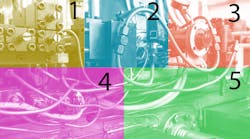Even the smallest contaminants can cause major problems in a hydraulic system. Whether maintenance simply needs to be performed more frequently or particles make their way into the system, causing damage to the machinery, significant downtime could result from contaminated fluid.
With the proper filtration technology for your industry’s application, you can ensure that contaminants are removed from your hydraulic system well before they can cause damage and shutdowns. Regardless how contaminants enter the hydraulic system, the right filtration solution can address the issue.
Reducing Contaminants
Because clean fluids are essential to the functionality of a hydraulic system, finding and reducing contaminants is a critical part of hydraulic maintenance. When contamination isn’t minimized, significant and often unplanned downtime is the result.
So how do contaminants make their way into hydraulic systems to begin with? Some unwanted particles may be remnants of the manufacturing process. It’s common for things like pieces of rubber or even metal debris from machinery to make their way down the line, causing potential damage.
One way to avoid this issue is to perform a complete system flush before initial use.
Some contamination may also be caused during normal operations. Frequent rotation of pumps, for example, may lead to eventual wear on the system, causing unwanted particles to form.
Although these guidelines are basic, they often can get overlooked:
- Use quality filters in the hydraulic system, and have filters cleaned on a regular basis. Follow manufacturer guidelines on how often to change out the filters and fluids.
- Imperfect seals and openings in the hydraulic components, like breather caps, may also contribute to contamination in the system. The area around the system should be clean, and using high-quality breather caps is also an important consideration.
- When hydraulic hoses come loose, or seals begin to leak, repair them as soon as possible so contaminants do not make their way into the machinery and through the hydraulic line.
- One of the leading causes of unwanted particles within the hydraulic system is the fluid that is added to the system. Even new oil is not considered contaminant-free, and it should be filtered to the correct specifications before use.
- Conducting periodic fluid analysis can identify additional contamination sources.
Basket Strainers
Many filtration options require filters that need to be replaced frequently. Basket strainers conduct a high level of filtration, but instead of replacing the filter each time it becomes full, a basket strainer can simply be cleaned and returned to the hydraulic system, making it a cost-effective option.
One type of basket strainer is the simplex strainer. It’s a single basket, typically made of stainless steel or cast iron, and can be used in both low- and high-pressure applications. They are frequently installed as return line filters, inline filters and suction filters. While they are versatile, the downside to simplex filters is that the system will need to be shut down briefly when the filter needs to be cleaned.
Duplex filters offer the same advantages as simplex filters, but they do not require a system shutdown for cleaning. The filter is equipped with two baskets. When one needs to be cleaned, simply switch the hydraulic system to the other basket, with no downtime required. Whether choosing simplex or duplex for your hydraulic system, it is important to select a basket strainer with no leakage.
Like basket filters, bag filters are another cost-effective option for removing contaminants from hydraulic fluid. These filters employ a cloth bag to filter out unwanted particles as they pass through the line. The size of the pores on the bag determines the amount of filtration that can be achieved. Large pores, for instance, will only filter out larger particulates, while smaller pores will provide a finer filtration. Bag filters are commonly used in a variety of hydraulic systems associated with food and chemical processing, water treatment and more.
Cartridge Filtration Systems
The round, pleated filters in cartridge filtration are designed to remove small particles and contaminants that could cause damage to the machinery in the hydraulic system. While they are extremely effective at removing unwanted materials from hydraulic fluid, they do require some minimal downtime for cleaning or replacement. However, they are the preferred filtration choice for many industries, including pharmaceutical and petroleum.
Self-Cleaning Filters and Strainers
Occasionally, regular maintenance and system downtime of any kind may not be ideal, especially in applications where hazardous chemicals are present or flow rates and pressure are high. Self-cleaning filters provide the same level of contamination filtration as other filtration technologies, without the need to shut the system down for regular filter cleaning or replacement. This is due to the complex design, where continuous backwash at the output allows the filter mesh to remain clean. Cooling towners and tubular backwashing filters use self-cleaning filtration technology.
Reverse Osmosis Systems
When water is the primary fluid in a hydraulic system, reverse osmosis, or RO, systems may be the best option. During the reverse osmosis process, water is forced through a semi-permeable membrane, where particles of all sizes are removed and purification is achieved. Industries that utilize RO systems include water purification facilities, food processing plants and even oil refineries.
Reducing Hydraulic System Downtime
Downtime is more than just a hassle. From the impact on productivity to the employee time needed for repairs, the bottom line is always affected. To reduce downtime in your hydraulic system, you must first reduce the contamination in the hydraulic fluids. While contamination is caused by a variety of factors, including manufacturing, environment and general wear-and-tear of equipment, unfiltered fluid may be the leading cause.
Fortunately, the solution is simple: Implement a high-quality filtration system. Once installed, your filtration system will work to remove unwanted particles from hydraulic fluid, resulting in systems that run at peak performance, with very little need for downtime.
Mark Ligon is the marketing manager at Commercial Filtration Supply, a distributor/supplier of industrial filtration products, including self-cleaning strainers, bag filtration, cartridge filtration and replacement parts.

